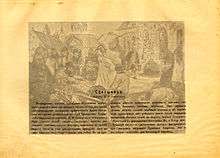Darya Nikolayevna Saltykova
- Not to be confused with Darya Petrovna Saltykova.
| Darya Nikolayevna Saltykova | |
|---|---|
 Darya Nikolayevna Saltykova punishing one of her serfs. There are no known portraits, from life, of Darya Nikolayevna Saltykova, except lubok and fantasy pictures. In pictures on the internet, she is often confused with Darya Petrovna Saltykova and Madame Drouais. | |
| Born |
Darya Nikolayevna Ivanova November 3, 1730 |
| Died | December 27, 1801 (aged 71) |
| Cause of death | unknown |
| Other names | The Saltychikha |
| Criminal penalty | Life imprisonment |
| Killings | |
| Victims | 38-147 |
Span of killings | 1755?–1762 |
| Country | Russian Empire |
Date apprehended | 1762 |
Darya Nikolayevna Saltykova (Russian: Дарья Николаевна Салтыкова; née Ivanova, commonly known as Saltychikha) (1730 – December 27, 1801) was a Russian noblewoman, sadist, and serial killer, from Moscow, who became notorious for torturing and killing over 100 of her serfs, mostly women and girls. Saltykova has been compared to the earlier, Hungarian, "Blood Countess", Elizabeth Bathory, who committed similar crimes, in her castle, against servant girls and the local serfs, of torture and serial murder.
Early life
Darya Nikolayevna was born to the Russian nobles, Nikolai Avtonomovich Ivanov and Anna Ivanovna Davydova.
Marriage and family
Darya Nikolayevna Saltykova married the noble Gleb Alexeyevich Saltykov, uncle of Nikolai Saltykov. Darya Nikolayevna married young, into the famous Saltykov Family. She had two sons: Theodore (1750-1801) and Nicholas (d. 1775). Darya Saltykova was widowed in 1755 at the age of 26. With her husband's death she inherited a substantial estate, where she lived with her two young sons and a great number of serfs.
Sadist and serial killer
Many early complaints to authorities about the deaths at the Saltykova estate were ignored, or resulted in punishment for complaining. Darya Nikolayevna was well connected with those in power at the Russian royal court and with the Russian nobility. Eventually relatives of the murdered women were able to bring a petition before Empress Catherine II. Catherine decided to try Saltykova publicly, in order to further her "lawfulness" initiative. Saltykova was arrested in 1762.
Darya Nikolayevna Saltykova was held for six years until 1768 while the authorities conducted a painstaking investigation. Catherine's Collegium of Justice questioned many witnesses and examined the records of the Saltykova estate. The investigating official counted as many as 138 suspicious deaths, of which the vast majority were attributed to Saltykova.
Darya Nikolayevna Saltykova was found guilty of having killed 38[1][2] female serfs by beating and torturing them to death, but the Empress Catherine was unsure how to punish her; the death penalty was abolished in Russia in 1754, and the new Czarina needed the support of the nobility.
Imprisonment and death
In 1768, Darya Nikolayevna Saltykova was chained on a public platform in Moscow for one hour, with a sign around her neck with the text: "This woman has tortured and murdered." Many people came to look at her while she was being scornfully ridiculed. Afterward, Saltykova was sent to imprisonment for life, in the cellar of Ivanovsky Convent in Moscow. Darya Nikolayevna Saltykova died on December 27, 1801 and was buried next to her relatives in the Donskoy Monastery necropolis.
See also
Sources
- История России. Всемирная, мировая история - Салтычиха(Салтыкова Дарья Николаевна) (Russian)
- Simon Sebag Montefiore: Potemkin
References
- ↑ История России. Всемирная, мировая история - Салтычиха(Салтыкова Дарья Николаевна) (Russian)
- ↑ German Wikipedia on Darya Saltykova